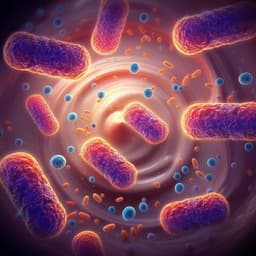
Biology
Environmental microbiome diversity and stability is a barrier to antimicrobial resistance gene accumulation
U. Klümper, G. Gionchetta, et al.
This groundbreaking study by Uli Klümper and colleagues uncovers how microbial diversity can serve as a natural barrier against the spread of antimicrobial resistance (AMR). Through extensive research in rewilded European environments, the team found that higher soil diversity significantly reduces the persistence of harmful antibiotic-resistant bacteria and genes. Discover how these findings could reshape our understanding of AMR dynamics!
~3 min • Beginner • English
Introduction
Antimicrobial resistance (AMR) poses a major threat to human and animal health, necessitating a One Health approach that integrates environmental dimensions. Environmental microbial communities are frequently exposed to ARGs and ARB via anthropogenic inputs (e.g., wastewater, manure) and diffuse natural sources (wildlife, aerosols). Invasion theory predicts that successful establishment of immigrants depends on overcoming a habitat’s biotic resistance, which should strengthen with increasing biodiversity due to fuller niche occupation and competition. Disturbances can transiently open niches and facilitate invasion. The study asks whether higher bacterial diversity in environmental microbiomes limits ARG accumulation and pervasiveness. The authors hypothesize that AMR dissemination is inversely related to microbial diversity, particularly in structured, relatively stable environments such as soils, compared to dynamic environments like riverbeds.
Literature Review
The work builds on ecological invasion theory and the diversity–invasion effect, wherein more diverse communities resist invaders via more complete niche occupation and stronger competition. Prior laboratory and microcosm studies showed diversity can hinder ARB invasion in soils and that environmental stress can increase invasion success in river biofilms. River biofilms and activated sludge have been considered hotspots for HGT due to high bacterial densities and resources. Natural environments may host ancient, intrinsic ARGs; however, anthropogenic activities enrich and spread mobile ARGs. Previous research also suggests that community structure, connectivity, and evenness can influence resilience, niche partitioning, and the likelihood of horizontal gene transfer. Despite these insights, a landscape-scale test linking environmental microbiome diversity to ARG accumulation across terrestrial and aquatic habitats had been lacking.
Methodology
Design: Pan-European sampling of low anthropogenic impact sites across seven countries during fall/winter 2020/21, targeting two habitat types: (1) forest soils (structured, stationary environments) and (2) riverbeds (epilithic biofilms from rock undersides and surface sediments; dynamic environments). Site selection aimed to avoid recent fecal or waste inputs. Field and extraction blanks controlled for contamination.
Sampling and processing: River samples comprised composite epilithic biofilms (scraped from five rocks per site) or composite surface sediments (upper 5 cm from five cores). Samples were transported on ice, centrifuged, pellets stored at −20 °C. DNA was extracted with DNeasy PowerSoil Pro Kit.
16S rRNA amplicon sequencing: Illumina MiSeq (V3–V4 region; primers 341F/806R variants provided), minimum 10,000 reads per sample. Reads were processed in R with DADA2, adapter trimming via cutadapt, taxonomy via SILVA v138. Alpha diversity indices (Chao1 richness, Shannon diversity, Pielou evenness) were computed on rarefied data in QIIME2; beta-diversity via Bray–Curtis PCoA and PERMANOVA.
ARGs, MGEs, and markers: High-throughput qPCR (SmartChip) quantified 27 ARGs and 5 MGE markers, plus 16S rRNA gene and crAssphage (human fecal pollution indicator). CT threshold 31; quantification limit ~25 copies per reaction. Non-specific melts were excluded. Relative abundances were normalized to 16S rRNA gene using a comparative CT approach.
Statistics: Group comparisons used one-way ANOVA with Tukey HSD. Correlations between ARG metrics (number detected and individual relative abundances) and diversity indices used Pearson or Spearman tests with Bonferroni correction for multiple testing. Significance of mean correlations against zero used t-tests. Community similarity assessed via pairwise Bray–Curtis dissimilarities; subsets formed by top 20% and bottom 20% of samples by total ARG abundance. All analyses in R 4.2.0.
Data availability: 16S data deposited in NCBI SRA (PRNA948463). Supplementary datasets provide ASV tables, diversity indices, ARG/MGE measurements, and dissimilarities.
Key Findings
- Soil vs river diversity and contamination check: CrAssphage was undetected in all soils and in 78% of rivers, and when present in rivers was ≤10^-6 per 16S copy, supporting low recent fecal impact. Soil and river communities differed significantly (PERMANOVA p < 0.001).
- ARG detection breadth: In rivers, 18.44 ± 5.61 of 72 tested ARGs detected per sample on average; soils had fewer, 15.95 ± 6.05 per sample (ANOVA p = 0.014, F = 6.11). The aminoglycoside gene cadA3-V1 was among the most abundant in both datasets; rivers also showed dominance of sul1, vanA, mcr1, and phenicol-related determinants. Soils often showed higher abundance of cadA3-V1, dfrA1, mphA, qnrS.
- Diversity as barrier in soils: Number of detected ARGs per soil sample negatively correlated with diversity metrics: Pielou evenness (Spearman r = −0.35, p = 0.0042), Shannon (r = −0.37, p = 0.0027), and a marginal trend for Chao1 richness (r = −0.25, p = 0.051). Effect sizes suggest diversity explains roughly 25–37% of the variation in ARG counts.
- Gene-level correlations: In soils, a high proportion (>85%) of individual ARGs showed significant negative correlations between relative abundance and diversity indices after multiple-testing correction, especially for evenness and Shannon. In rivers, no consistent pattern; only a positive correlation was detected for blaZ-like (blazR) with Chao1 (R = 0.422, p = 0.0008); other ARG-diversity correlations were weak and non-significant.
- Host inference: Correlations between ASVs and ARGs did not reveal clear single-host relationships across geographic scales; most ARGs correlated positively with many ASVs, suggesting multiple potential hosts and supporting analysis at the community level.
- Community similarity vs ARG load: Samples in the top 20% by total ARG abundance were more similar to each other (lower pairwise Bray–Curtis dissimilarities) than average, while bottom 20% samples were more dissimilar than average. ANOVA with Tukey HSD showed significant differences (multiple adjusted p-values < 0.05) in both river and soil datasets, indicating high ARG abundance is associated with more phylogenetically similar communities, whereas low ARG abundance is widespread across diverse community compositions.
Discussion
Findings support the hypothesis that higher microbial diversity can impede ARG accumulation, with strong evidence in structured, relatively stable soils and limited evidence in dynamic river environments. In soils, fuller niche occupation, stronger competition, and greater evenness likely reduce immigrant ARB residence time and opportunities for horizontal gene transfer (HGT), thereby lowering both ARG counts and abundances. The stronger association with evenness suggests that balanced communities resist invaders more effectively than merely species-rich but uneven ones. In rivers, frequent mixing, transient niches, and disturbance may mask diversity-based barrier effects. Exceptionally, some β-lactam genes showed positive relationships with diversity, consistent with their occurrence as part of natural background resistomes in less impacted settings. Community similarity analyses imply that high ARG loads occur in more specific community types (specialist pattern), whereas low ARG loads are a general trait associated with diverse communities. Overall, the results align with invasion theory and highlight diversity as a potential ecological barrier to AMR dissemination in environmental microbiomes, especially in soils.
Conclusion
This study provides pan-European evidence that in structured soil environments, higher bacterial diversity—particularly evenness—is associated with fewer and less abundant ARGs, suggesting diversity serves as a natural barrier to AMR dissemination. Conversely, in dynamic riverbeds, diversity effects were weak or absent, likely due to transient niche structures and frequent mixing. These insights emphasize the value of maintaining healthy, diverse environmental microbiomes within the One Health framework and suggest practical applications, such as prioritizing intrinsically diverse zones (e.g., for aquifer recharge) to limit spread of wastewater-borne ARGs. Future research should perform targeted, mechanistic experiments to disentangle how diversity limits ARG proliferation and HGT, identify key community traits driving resistance to invasion, and refine monitoring frameworks integrating diversity metrics with resistome assessments.
Limitations
- River dataset showed limited or no significant diversity–ARG relationships, potentially due to small effective sample sizes for some analyses, higher environmental variability, and dynamic mixing that obscures long-term patterns.
- Cross-sectional observational design limits causal inference; correlations do not prove that diversity reduces ARGs.
- ARG host identification via correlation was inconclusive; many ASVs correlated with each ARG, and putative hosts were not supported by prior literature, indicating the need for metagenomic host-resolved approaches.
- Effect sizes in soils (about 25–37%) indicate additional unmeasured drivers (e.g., physicochemical variables, legacy contamination, local selection pressures) also influence ARG patterns.
- Some reported sample counts in the narrative appear inconsistent across sections, reflecting potential typographical errors; however, overall patterns remain robust across datasets.
- HT-qPCR targeted a defined panel (27 ARGs and 5 MGEs), which may not capture the full resistome or all mobile elements; detection thresholds and normalization to 16S introduce additional uncertainty.
Related Publications
Explore these studies to deepen your understanding of the subject.







